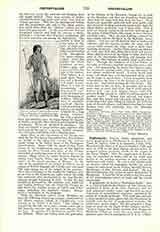

Tiefentaller, JOSEPH, Jesuit missionary and noted geographer in Hindustan, b. at Bozen in the Tyrol, August 27, 1710; d. at Lucknow, July 5, 1785. He entered the Society of Jesus October 9, 1729, and went in 1740 to the East Indian mission where he occupied various positions, chiefly in the empire of the Great Mogul. After the suppression of the Society he remained in India, and on his death was buried in the mission cemetery at Agra, where his tombstone still stands. He was a fine scholar with an unusual talent for languages; besides his native tongue he understood Latin, Italian, Spanish, French, Hindustani, Arabic, Persian, and Sanskrit. He was the first European who wrote an exact description of Hindustan. A brief list of his works is the best proof of his extraordinary power of work and his varied scholarship.
In geography, he wrote a “Descriptio Indiae”, that is a circumstantial description of the twenty-two provinces of India, of its cities, fortresses, and the most important smaller towns, together with an exact statement of geographical positions, calculated by means of a simple quadrant. The work also contains a large number of maps, plans, and sketches drawn by himself, and the list of geographical positions fills twenty-one quarto pages. He also prepared a large book of maps on the basin of the Ganges, entitled: “Cursus Ganges fluvi Indiae maximi, inde Priaga seu Elahbado Calcuttam usque ope acus magneticae exploratus atque litteris mandatus a J. T. S. J.” (1765).
The original map of the lower course of the river measures 15′, that of the middle course, from Benares to Patna, measures 4′ 3″ square. In addition there is a map of similar dimensions of the Gagra, the whole accompanied by numerous notes, sketches of particular parts, and maps giving details—an “enormous labor”, as Bernoulli calls it. He also wrote a work on the regions containing the sources of the chief rivers of India. In the field of religions he wrote on Brahminism a work directed against the errors of the Englishmen Z. Holwell and Alexander Dow. Others of his writings were on Indian idolatry, Indian asceticism, the religion of the Parsees, Mohammedanism, the relations of these religions to one another, etc. His writings in the department of the natural sciences are: astronomical observations on the sun-spots and the zodiacal light, studies on the astronomy, astrology, and cosmology of the Hindus, descriptions and observations of the flora and fauna of India. The department of history is represented by writings in Latin on the origin of the Hindus and of their religion, an account in German of the expeditions of Nadir Shah to India, the deeds of the Great Mogul Shah Alam in Persian, and in French the incursions of the Afghans and the conquest of Delhi, and the contemporary history of India for the years 1757-64. In linguistics he wrote a Sanskrit-Parsee lexicon, treatises in Latin on the language of the Parsees, on the proper pronunciation of Latin, etc.
Tieffentaller sent these works in manuscript partly to the Danish scholar Dr. Kratzenstein at Copenhagen, partly to the celebrated French Orientalist and geographer A. H. Anquetil-Duperron (1731-1805). The latter gave due credit to the value and importance of the works, especially those on geography, in his addresses before the French Academy of Sciences (“Journal des Scavans”, December, 1776), and made the writings of Tieffentaller partly accessible to the learned world in his “Recherches hist. et geogr. sur l’Inde” (1786), and also in his “Carte generale du tours du Gange et du Gagra dressee par les cartes particulières du P. Tieffenthaler” (Paris, 1784). A part of the manuscripts at Copenhagen were obtained by the German scholar Johann Bernoulli of Berlin who used them in connection with the “Recherches” of Anquetil for the great work “Des Pater Joseph Tieffenthalers d. Ges. Jesu and apost. Missionarius in Indien historisch-geographische Beschreibung von Hindustan …” (3 volumes, quarto, Berlin-Gotha, 1785-87). The greater part of the first two volumes is devoted to Tieffentaller’s writings, his maps, and sketches. The French edition, entitled: “Description hist. et geogr. de l’Inde …”, appeared at Berlin in three vols., 4to (1786-91). A large part of his manuscripts are probably still extant in Paris and Copenhagen.
A. HUONDER

